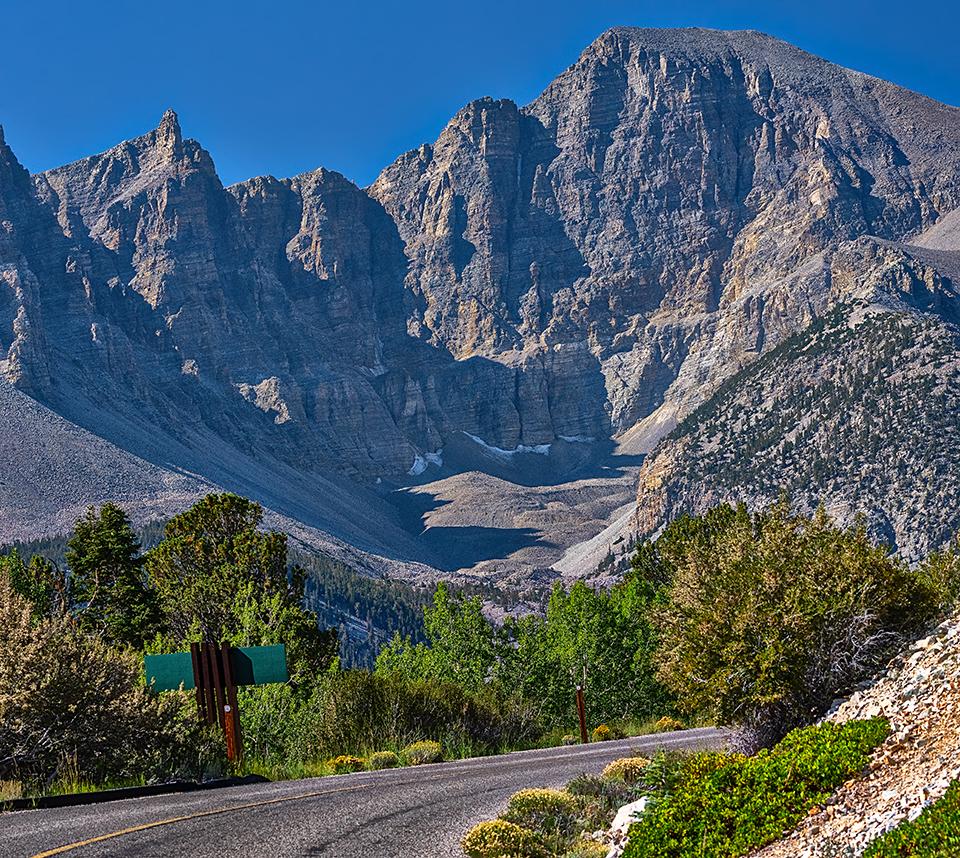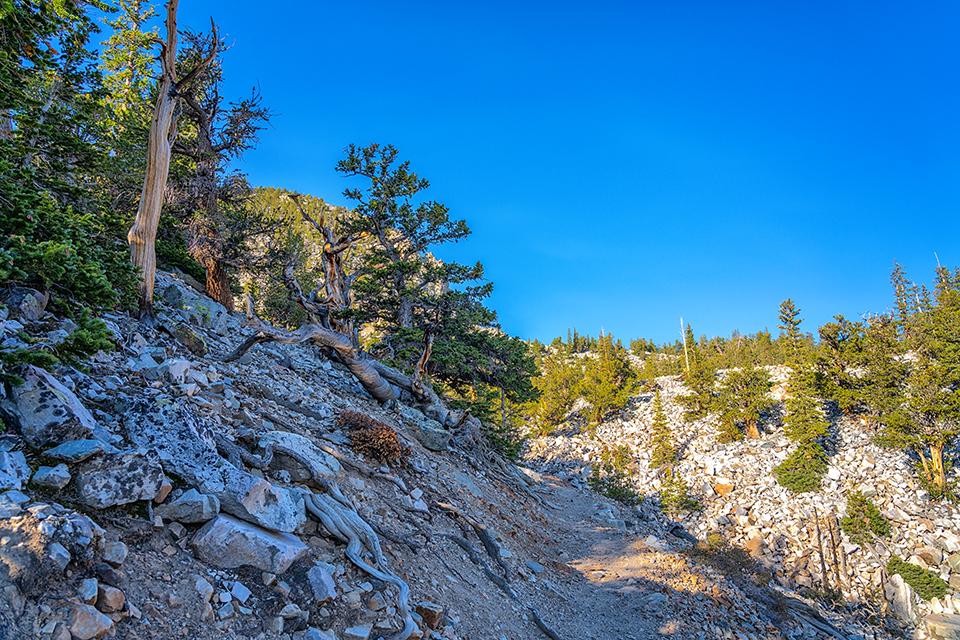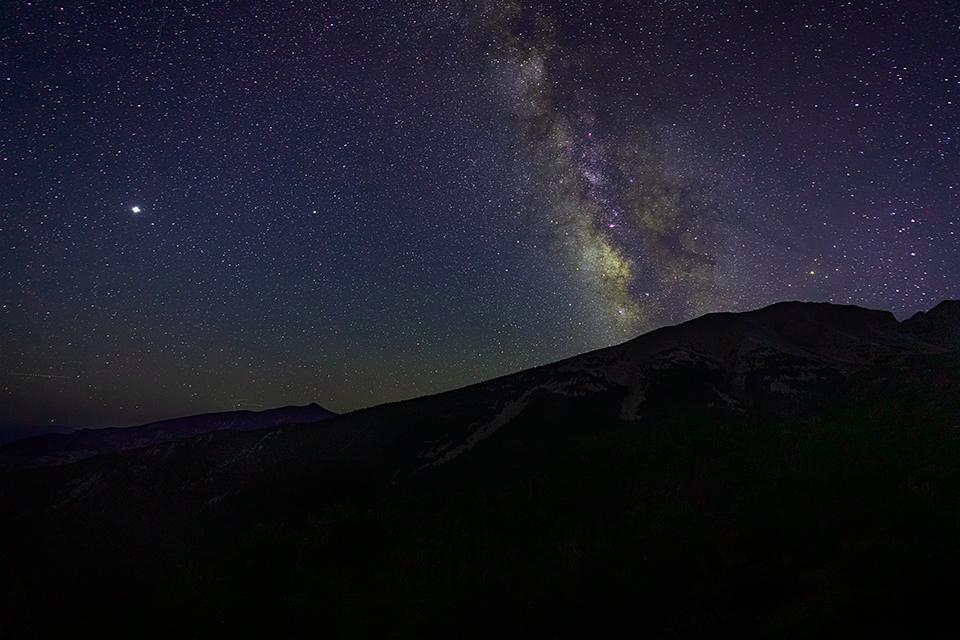
Sunrise at Mather Overlook, Great Basin National Park / Rebecca Latson
On the heels of my visit to Yosemite National Park in California, I drove 5 hours to Great Basin National Park in Nevada to see what this over-77,100-acre park offered. I learned quite a bit during my short stay and share it with you in the form of this quiz and trivia piece. See how much you know before checking the answers at the bottom.
1. Great Basin National Park gets its name from “the huge geographic area where waters have no outlet to the sea. Streams and rivers drain into shallow salt lakes, marshes, and mud flats, eventually evaporating in the dry desert air.” True or False: Great Basin is one huge basin.
a) True
b) False
2. In 1986, Congress set aside Great Basin National Park to protect and preserve:
a) The Sierra Nevada Range
b) The South Snake Range
c) The Wasatch Range
d) The San Jacinto Range

Wheeler Peak, Great Basin National Park / Rebecca Latson
3. True or False: Wheeler Peak is the tallest mountain in the central Great Basin.
a) True
b) False

A room full of cave formations within Lehman Caves, Great Basin National Park / Rebecca Latson
4. A visit to Great Basin National Park is not complete until you’ve reserved a spot on a Lehman Caves guided tour. You’ll see all sorts of strange and beautiful formations during the tour. These formations are collectively known as:
a) Speleothems
b) Flowstone
c) Cave pearls
d) Pool deposits
5. True or False: Weddings were once performed in Lehman Caves.
a) True
b) False

Hiking the Bristlecone Trail, Great Basin National Park / Rebecca Latson
6. Another must-do item when visiting Great Basin is to hike a trail to one of the park’s Great Basin Bristlecone pine groves. The most accessible of these groves is reached via the Bristlecone Trail located at the end of Wheeler Peak Scenic Drive, but this is not the only grove to which you can hike. How many groves can you hike to in this national park?
a) Three
b) Four
c) Five
d) Six
7. Great Basin National Park is home to one native fish species:
a) Lahonton cutthroat trout
b) Rainbow trout
c) Brown trout
d) Bonneville cutthroat trout
8. Great Basin National Park has ____ zones of habitat.
a) Four
b) Five
c) Six
d) Seven

A spiky white flower, Great Basin National Park / Rebecca Latson
9. While sitting in my vehicle at the Lehman Caves Visitor Center, I noticed this beautiful, but rather spiky, white flower growing in one of the parking lot medians as well as alongside the road. I only saw it there, and nowhere else in the park. Doesn’t mean it wasn’t growing elsewhere – I just didn’t see it anywhere else. I later found out this flower is called ____.
a) Thorny cup
b) Prickly poppy
c) White thistle
d) Beeweed

A busy little hummingbird, Great Basin National Park / Rebecca Latson
10. ____ species of birds have been reported within Great Basin National Park and vicinity.
a) 133
b) 253
c) 367
d) 415
Trivia

Cave shields in the early stages in Lehman Caves, Great Basin National Park / Rebecca Latson

Cave shields at a later stage of development in Lehman Caves, Great Basin National Park / Rebecca Latson
Pictured above are a particular type of speleothem called “cave shields.” Initially, they look like that first image: a couple of discs begin to form from two parallel plates of calcite with a very thin crack between the plates – you might not even be able to see the crack. As calcium carbonate-laden water begins to flow between these shields, the water acts much like the spray you get when you hold your thumb down over the top of a hose. As the mineral-laden water originally under pressure is now released into the atmosphere, the calcite precipitates out and accumulates, drop-by-drop, into the beautiful flowing speleothem you see in the second image. There are over 300 cave shields in Lehman Caves. To learn more about cave shields, click here.

The shape and placement of Bristlecone pine needles, Great Basin National Park / Rebecca Latson

The shape and placement of Limber pine needles, Great Basin National Park / Rebecca Latson
When you visit a bristlecone grove, you may encounter limber pines and bristlecones growing side by side, since limber pines can also grow at high elevations. The best way to distinguish the Great Basin Bristlecone pine from the Limber pine is to look at the needles, which on the bristlecones are about one-inch-long and grow in packets of five. The needles completely surround the branches in tightly-bunched tufts. Also, the needles may extend back a foot or more along the branch, giving it the appearance of a bottle brush. The developing cones are a deep purple color, which helps absorb the sun’s heat, and then, after two years the cones mature and turn brown in color. The tree gets its name from these cones, whose scales are each tipped with a claw-like bristle—hence, the “bristlecone.” The Limber pine trees, on the other hand, have needles in packets of five that are 1 1/2 to 3 inches long, which only grow toward the ends of branches. Also, the cones of the limber pine do not have the trademark bristles.

The Milky Way over Doso Doyabi at Mather Overlook, Great Basin National Park / Rebecca Latson
Among other things for which Great Basin National Park is known is the star-studded night sky above. In 2016, this park was designated an International Dark Sky Park. “On a clear, moonless night in Great Basin National Park, thousands of stars, numerous planets, star clusters, meteors, man-made satellites, the Andromeda Galaxy, and the Milky Way can be seen with the naked eye. The area boasts some of the darkest night skies left in the United States. Low humidity and minimal light pollution, combined with high elevation, create a unique window to the universe.” Anywhere within the park is a great place to sit and watch (or photograph) the night sky. Mather Overlook along Wheeler Peak Scenic Drive is wonderful and easily accessed. To learn more about stargazing on your own in this park, click here. To learn more about the park’s astronomy program, click here.
Quiz Answers
1b False
“Great Basin contains many smaller basins separated by mountain ranges running north to south. This undulating basin-and-range topography stretches across Nevada and into four other states.”
2b
Great Basin National Park protects the South Snake Range, “a small representative piece of the entire {Great Basin] region.” To learn more about the Great Basin, the Basin and Range region, and the Great Basin Desert, click here.
3a True
Wheeler Peak, at 13,063 feet (3,982 m), is the tallest mountain in the central Great Basin. If you feel adventurous, you can take the trailhead just off of Wheeler Peak Scenic Drive and hike 8.2 miles (roundtrip) to the Wheeler Peak summit. To learn how this mountain got its name, click here.
4a
The collective name for cave formations is speleothems. To learn more about the speleothems found in Lehman Caves, click here.
5a True
Weddings were performed in the cave. Musical selections were played on the stalactites and stalagmites. To learn more about the history of Lehman Caves, click here.
6a
There are three Great Basin Bristlecone groves to which you can hike: Wheeler Peak Grove (the most accessible grove), Mount Washington Grove (the largest grove), and the Eagle Peak Grove. To learn more about the bristlecones of Great Basin National Park, click here.
7d
Bonneville Cutthroat Trout are found only in the Great Basin region, having evolved from other cutthroat trout species after the Bear River became a tributary of Lake Bonneville 30,000 years ago. This species can tolerate streams with high water fluctuations and a wide range of water quality conditions better than most other trout species. To learn more about “fish in the desert,” click here.
8d
Great Basin National Park has seven major zones of habitats, depending on the elevation:
- Intermountain Cold Desert Scrub (below 5,000 ft.)
- Sagebrush and Grasslands (5,000-7,000 ft.)
- Piñon-Juniper Woodlands (6,000-8,000 ft.)
- Mixed Conifer Forest (7,000-10,000 ft.)
- Subalpine (9,500-11,800 ft.)
- Alpine (above 10,500 ft.)
- Riparian (throughout the park)
9b
“Prickly Poppy is the name used for various species of the Argemone Genus, all virtually indistinguishable from each other. Members of the Poppy Family are characterized by flowers with numerous stamens and 4 to 6 petals. This very branchy, pale green plant grows to 4 feet high and is covered with yellow pricklies. Long, very lobed, spiny leaves resembling thistles grow to 8 inches. All parts of this plant contain alkaloids that are poisonous. It is common throughout the West because not even cattle eat it. Various nicknames for this flower are ‘thistle poppy,’ ‘chicalote,’ ‘cowboy’s fried egg.’ It’s found throughout Southwest deserts, including Great Basin Desert.”
10b
Great Basin National Park is an excellent place to enjoy bird watching, as 253 species have been reported within the park and the vicinity, which includes Snake Valley and the north and south Snake Ranges. Click here for a list of birds seen (last updated 2017).
References
In addition to the information found on the NPS.gov website for Great Basin National Park, I used the following as reference:




 Support Essential Coverage of Essential Places
Support Essential Coverage of Essential Places






